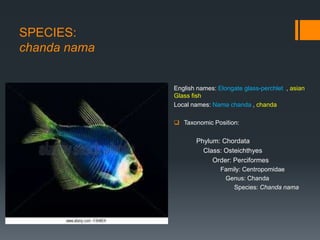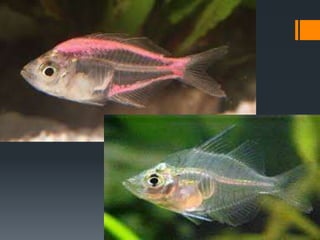Chanda fish(chanda nama)
- 1. Fresh water fishes of bangladesh Genus : CHANDA
- 2. INTRODUCTION: 1. small ovate and fairly transparent fishes 2. having vertebral column with its adjoining elements 3. supraorbital ridge smooth, ending in an indistinct spine 4. mouth large with a conspicuous lower jaw 5. teeth villiform on the jaws 6. scales minute, partly deciduous 7. lateral line indistinct
- 3. Nama chanda and Fali chanda
- 4. SPECIES: chanda nama English names: Elongate glass-perchlet , asian Glass fish Local names: Nama chanda , chanda Taxonomic Position: Phylum: Chordata Class: Osteichthyes Order: Perciformes Family: Centropomidae Genus: Chanda Species: Chanda nama
- 5. Description: External feature: 1. Body ovate & strongly compressed. 2. Mouth large with a prominent lower jaw. 3. Teeth villiform on the jaw. 4. Scales minute, often irregularly arranged. 5. Lateral line with 100-107 scales. 6. Caudal fin black & orange :Habits & Habitats 1. Lives in fresh & brakish waters, both in standing & running waters. 2. Swims through the flooded paddy fields in schools during the rainy season. 3. Breeds everywhere during the rainy season.
- 6. Morphological description: 1. Body is compressed & laterally flat. 2. Dorsal & ventral profile is almost equally convex. 3. Lateral line is partly distinct. 4. Second dorsal spine is longest. 5. Scales are minute and rounded. 6. Caudal fin is forked & it is black and orange. 7. A small black spot is found at the origin of the base of anal fin. 8. Lower jaw is longer than upper jaw.
- 8. Economic importance: 1. Nama chanda is well known as a small indigenous species (SIS) of fish of bangladesh. 2. People use it as the part of their delicious food item. 3. It is very much famous food in rural bangladesh. 4. Good source of nutrition but low price in the market. 5. This species could effectively be used in the control of mosquito eggs & larvae. 6. Also used as an aquarium fish.
- 9. Ecological role: The presence of these fishes checks mosquito breeding only to a small extent while it effectively reduces the density of cyclops. So, this species could effectively be used in the control of guinea worms & also for malarial control.
- 10. Status & Conservation: Considered as vulnerable in the Red list of IUCN Bangladesh(2000). Habitat restoration and conservation measures are required to protect this fish.. Marketing status: Market price of fresh fish is recorded 30-50 TK/Kg
- 11. Remarks: Studies show that the fish feeds on the scales of other species of fish. Scale eating is predominantly seen in adults. The species dislodges the scales of its prey by ‘RAKING’ the flanks with its lower jaw, which is armed with curved conical teeth.. References: 1. Encyclopedia of flora and fauna of Bangladesh, Freshwater fishes, volume 23, p.180 2. Rahman, A.K.A. 2005. Freshwater Fishes of Bangladesh. The Zoological society of Bangladesh, Dhaka, P.339-340 Hamilton, F.1822. Fishes of the ganges, Archibad constable & company, Edinburgh, P.109
- 13. Thank you That’s all for the time being Created by… Md. Saiful islam Roll: ASH1602050M FIMS, 11 batch












